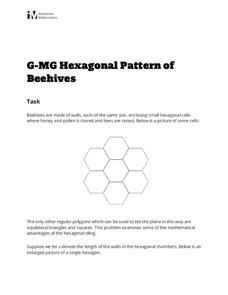Curated and Reviewed by
Lesson Planet
This Hexagonal Pattern of Beehives activity also includes:
- Answer Key
- Worksheet
- Join to access all included materials
Young geometers and biologists investigate the math of nature in an activity that is just the bee's knees. Participants will study the tessellations of hexagons in a beehive, along with the natural rationale behind the specific shape. Learners perform calculations to justify the bee's use of a hexagon, and then answer synthesis questions to provoke a deeper understanding of the identified characteristics.
1 Collection
47 Views
37 Downloads
CCSS:
Designed
Additional Tags
Instructional Ideas
- Could be part of a larger unit on math in nature (i.e. Fibonacci in flowers and shells, symmetries of sea creatures, etc.)
- Good review of equilateral triangle properties
- Could be used to introduce or justify general area of a polygon formulas
- Possible links to tessalation projects in art class
Classroom Considerations
- The more information link for Honeycomb Structure takes the reader to Wikipedia (which may be blocked in the classroom, or a forbidden source for research).
- Student worksheet is not separated from teacher notes
- Solutions require deep knowledge of triangles (trig ratios, equilateral triangle properties, etc.)
Pros
- Elegant and real-life example of math being applied in nature
- Calculations lead into fundamental properties of polygons
- Extension questions require synthesis and analysis beyond calculations
Cons
- Solution example comparing ratios of hexagon perimeter and area to that of a square or triangle is simply given without much explanation or justification (part b)



